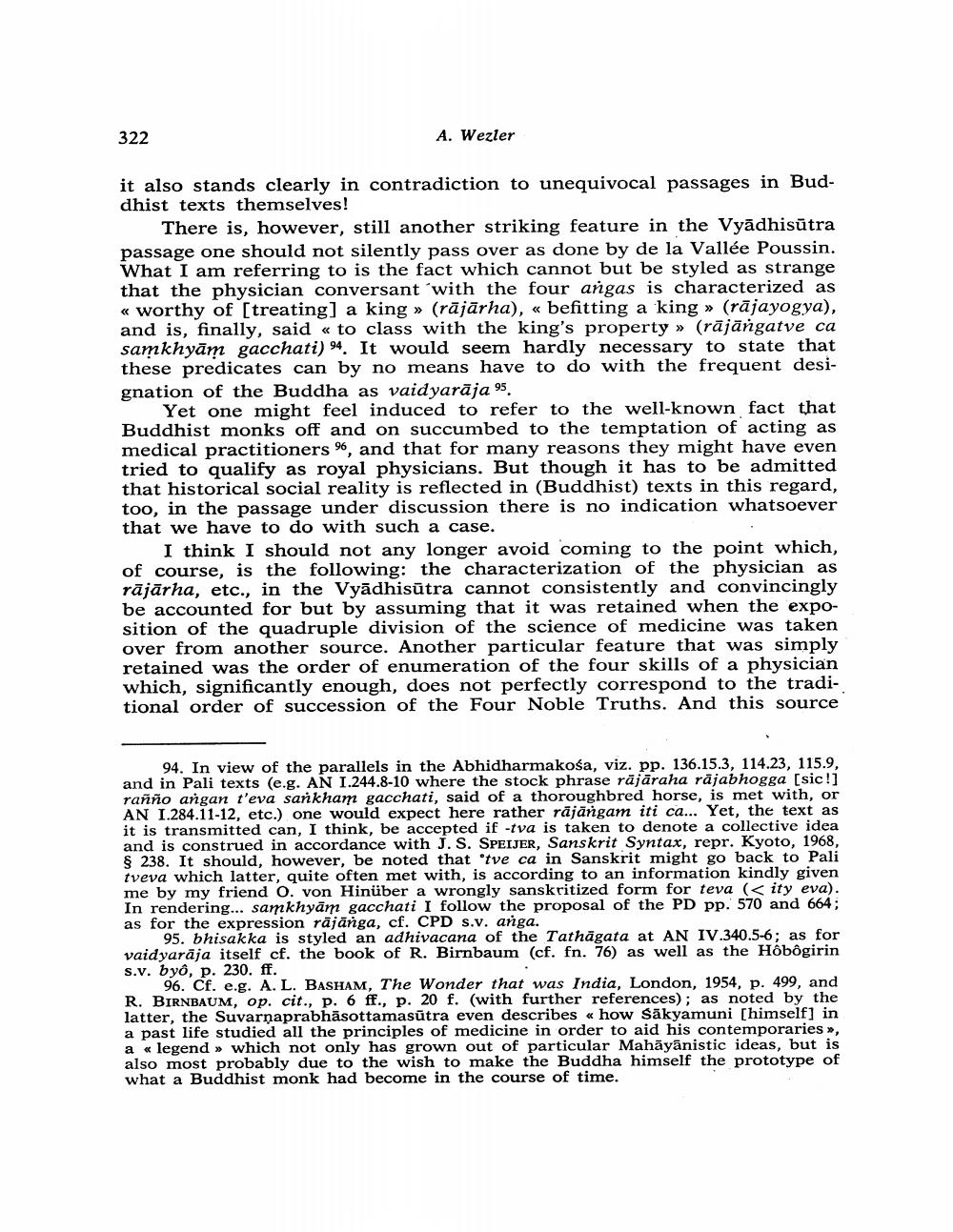________________
322
A. Wezler
it also stands clearly in contradiction to unequivocal passages in Buddhist texts themselves!
There is, however, still another striking feature in the Vyādhisātra passage one should not silently pass over as done by de la Vallée Poussin. What I am referring to is the fact which cannot but be styled as strange that the physician conversant with the four argas is characterized as « worthy of [treating] a king » (rājārha), « befitting a king » (rājayogya), and is, finally, said « to class with the king's property » (rājāngatve ca samkhyām gacchati) 94. It would seem hardly necessary to state that these predicates can by no means have to do with the frequent designation of the Buddha as vaidyarāja 95.
Yet one might feel induced to refer to the well-known fact that Buddhist monks off and on succumbed to the temptation of acting as medical practitioners %, and that for many reasons they might have even tried to qualify as royal physicians. But though it has to be admitted that historical social reality is reflected in (Buddhist texts in this regard, too, in the passage under discussion there is no indication whatsoever that we have to do with such a case.
I think I should not any longer avoid coming to the point which, of course, is the following: the characterization of the physician as rājārha, etc., in the Vyādhisūtra cannot consistently and convincingly be accounted for but by assuming that it was retained when the exposition of the quadruple division of the science of medicine was taken over from another source. Another particular feature that was simply retained was the order of enumeration of the four skills of a physician which, significantly enough, does not perfectly correspond to the traditional order of succession of the Four Noble Truths. And this source
94. In view of the parallels in the Abhidharmakośa, viz. pp. 136.15.3, 114.23, 115.9, and in Pali texts (e.g. AN 1.244.8-10 where the stock phrase rājāraha rājabhogga (sic!] rañño angan t'eva sarkham gacchati, said of a thoroughbred horse, is met with, or AN 1.284.11-12, etc.) one would expect here rather räjāngam iti ca... Yet, the text as it is transmitted can, I think, be accepted if -tva is taken to denote a collective idea and is construed in accordance with J. S. SPEIJER, Sanskrit Syntax, repr. Kyoto, 1968, § 238. It should, however, be noted that "tve ca in Sanskrit might go back to Pali tveva which latter, quite often met with, is according to an information kindly given me by my friend o. von Hinüber a wrongly sanskritized form for teva (< ity eva). In rendering... samkhyām gacchati I follow the proposal of the PD pp. 570 and 664; as for the expression rājānga, cf. CPD s.v. anga.
95. bhisakka is styled an adhivacana of the Tathāgata at AN IV.340.5-6; as for vaidyarāja itself cf. the book of R. Birnbaum (cf. fn. 76) as well as the Hôbôgirin s.v. byô, p. 230. ff.
96. Cf. e.g. A. L. BASHAM, The Wonder that was India, London, 1954, p. 499, and R. BIRNBAUM, op. cit., p. 6 ff., p. 20 f. (with further references); as noted by the latter, the Suvarnaprabhāsottamasūtra even describes «how Säkyamuni [himself] in a past life studied all the principles of medicine in order to aid his contemporaries, a « legend >> which not only has grown out of particular Mahāyānistic ideas, but is also most probably due to the wish to make the Buddha himself the prototype of what a Buddhist monk had become in the course of time.




